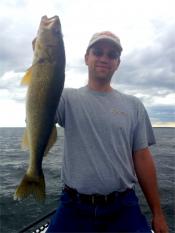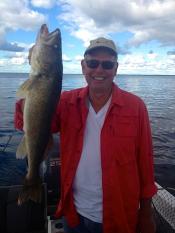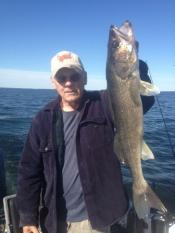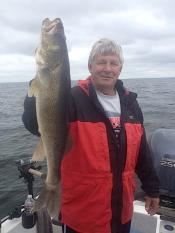 Over the last week, I conducted four Open Water Trolling Clinics on Mille Lacs Lake. The walleye anglers who attended these on the water clinics wanted to learn how to catch suspended walleyes out in the open basin which are not relating to any type of structure. Most of the anglers had all the open water trolling equipment and some open basin trolling experience using line counter reels, planer boards, lead core and crankbaits but wanted to fine tune their open water trolling skills so they could go back to their own boat and be successful. The focus of these clinics is learning how to break down the water and scout for these walleyes, learning how to use open water trolling equipment (trolling rods, line counter reels, planer boards, lead core etc…) and how to go about figuring out the four keys to success – crankbait depths, crankbait profiles, crankbait colors and speed. And oh yeah… they also got to catch over 100 walleyes!
Over the last week, I conducted four Open Water Trolling Clinics on Mille Lacs Lake. The walleye anglers who attended these on the water clinics wanted to learn how to catch suspended walleyes out in the open basin which are not relating to any type of structure. Most of the anglers had all the open water trolling equipment and some open basin trolling experience using line counter reels, planer boards, lead core and crankbaits but wanted to fine tune their open water trolling skills so they could go back to their own boat and be successful. The focus of these clinics is learning how to break down the water and scout for these walleyes, learning how to use open water trolling equipment (trolling rods, line counter reels, planer boards, lead core etc…) and how to go about figuring out the four keys to success – crankbait depths, crankbait profiles, crankbait colors and speed. And oh yeah… they also got to catch over 100 walleyes!
Due to the late ice conditions and the cool water temperatures that hung on through June, the open basin mud bite was behind about 3 weeks. In a normal year, I’m usually catching walleyes in-between and around the mud flats areas of the lake and primetime is mid to late June. This year was way behind – at least 3 weeks so I had to spend some serious time scouting to find these fish. I spent the majority of my time down in the south part of the lake catching fish down in the gravel and rock areas. These fish were relating more to perch profile crankbaits and perch color patterns. Storm Deep Thundersticks in Chrome Yellow Perch was the lure that was catching most of my fish trolled down deep with lead core. I would place these lures 2-4 feet off the bottom and troll speeds between 2.0-2.2 mph.
 Every once in awhile I would do some scouting around the mud flats to see if the tullibees and the walleyes have moved out there yet. I finally got a good report from a friend who attended my trolling clinic last year – Ryan Wellcome and he had some success around the mud flats. I decided to check it out last week and got into them pretty good so that’s where I’m now spending the majority of my time now.
Every once in awhile I would do some scouting around the mud flats to see if the tullibees and the walleyes have moved out there yet. I finally got a good report from a friend who attended my trolling clinic last year – Ryan Wellcome and he had some success around the mud flats. I decided to check it out last week and got into them pretty good so that’s where I’m now spending the majority of my time now.
It’s important to understand that these walleyes and the tullibees that they prey on will move up and down the water column. If you’re fishing early in the morning or until dark you want to move your crankbaits up higher in the water column. Tullibees feed at night and go up high to feed on daphnias, copepods, insect larvae and zooplankton. These fish are very heat sensitive and seek cool oxygen riched water. Towards evening, it’s amazing to see how these fish start to rise up and the big red arcs on my sonar do the same. It’s not uncommon for me to be fishing the upper 1/2 of the water column (typically around 10-15 feet down from the surface) during these low light periods. I feel my biggest weakness as an open water troller is not raising those baits up soon enough towards dark.
Storm Deep Thundersticks have been my go to bait as of late trolled with 3 colors of lead core. I like solid bright colors in the morning or when it’s cloudy out and then when the sun pops out, I change to chrome colors. The mad flash series gives off a great reflection from the sun.
 Now that the water temperatures have warmed up, I would like to remind everyone to handle these fish with care. Have your net, pliers, measuring stick and camera ready so that you can get that fish back in the water as soon as possible. I almost always have that fish back in the water in less than 20 seconds and anybody who has fished with me knows that! How you release a walleye when you’re trolling at 2.0 mph is different compared to when your boat is stationary. You don’t get a second chance because if you release the walleye prematurely and it bellies up, it’s very difficult to kick the motor in reverse and not tangle all your lines in order to get to the floating fish. Turning the boat around doesn’t work either because it takes too long. Long story short – you only get one shot.
Now that the water temperatures have warmed up, I would like to remind everyone to handle these fish with care. Have your net, pliers, measuring stick and camera ready so that you can get that fish back in the water as soon as possible. I almost always have that fish back in the water in less than 20 seconds and anybody who has fished with me knows that! How you release a walleye when you’re trolling at 2.0 mph is different compared to when your boat is stationary. You don’t get a second chance because if you release the walleye prematurely and it bellies up, it’s very difficult to kick the motor in reverse and not tangle all your lines in order to get to the floating fish. Turning the boat around doesn’t work either because it takes too long. Long story short – you only get one shot.
When releasing that fish, hold the walleye under its belly and do not hold it by its gill. Point it towards the bow of your boat so that the water is flowing freely through its gill. Take your time and don’t let go until the walleye swims off on its own. It also helps to hold it as deep as you can in the water – reason being is that the water on top of the surface is much warmer and doesn’t hold as much oxygen. Holding the walleye one or two feet below the surface will help. If the fish looks played out, don’t measure it and skip the photo – it’s just not worth killing it.
 It’s also important to know how to hold a walleye when removing crankbait hooks and when you’re taking pictures. I can’t remember the last time someone has dropped a fish in the bottom of my boat. Use your left hand on the left side of the fish or use your right hand on the right side of the fish. If you don’t use the proper hand, it puts too much pressure on that gill plate. Slide your index finger (and if it’s a bigger fish your middle finger) up the gill plate – do not touch the gill or place a finger in-between the gills. Now use your thumb to secure the fish and pinch your fingers together right behind the jawbone. Between the jawbone and on the gill plate is a thin piece of skin and that’s where your fingers should meet.
It’s also important to know how to hold a walleye when removing crankbait hooks and when you’re taking pictures. I can’t remember the last time someone has dropped a fish in the bottom of my boat. Use your left hand on the left side of the fish or use your right hand on the right side of the fish. If you don’t use the proper hand, it puts too much pressure on that gill plate. Slide your index finger (and if it’s a bigger fish your middle finger) up the gill plate – do not touch the gill or place a finger in-between the gills. Now use your thumb to secure the fish and pinch your fingers together right behind the jawbone. Between the jawbone and on the gill plate is a thin piece of skin and that’s where your fingers should meet.
The bigger the walleye, the more careful you need to be on handling these fish. I’ve been trolling the open basin for over 14 years and exclusively the last 7 years. Each year my boat catches hundreds of walleyes and I’m proud to say that I’ve knowingly killed less than 10 fish due to hooking mortality over the years.
I’ve been talking to many anglers and it sounds like the rigging bite is getting tougher out there now that the walleyes have finally begun the late summer patterns. Now’s the time to get out there to try pulling some crankbaits in the open basin. I always say, if you want to become a good open basin troller – leave your rigging rods at home and commit to trolling all day long!
Until next time – keep trollin’!
More pictures
Brad
Congrats on the continued Great success with your On The Water classes.
Very few boats can keep their nets wet ALL day long.
Anyone who wants to skip the slow learning curve on deep Walleye trolling should spend a day with Brad.

Jack
I got a chance to attend one of Brad Juarie’s on water, open basin trolling trolling seminars. I was a little familiar with lead core and planner boards. But I always felt like I was missing some key pieces of the puzzle. After spending a full day with Brad, I was finally able to see what I had been missing. Anybody from beginners to Pro’s should spend a day with Brad. He breaks everything down and makes it easy to understand. Thanks Again, Brad.
Great report, Brad!
How has the recent cold front effected the bite?
Once again a great report Brad! I’m still catching lots of fish on the chrome perch & the pink UV. I’ve also moved my baits up even at mid day when I see all that activity around the 15′ depth. Happy trolling!
Nice work as always Brad! Especially coming off that cold front. The leadcore and Thundersticks have definatly been on fire this year. I look forward to beating them up again this weekend!
I had the pleasure of attending Brads trolling clinic on Monday with my dad and a good friend. It was more than any of us expected. Brad broke down and explained everything we did, not just the hows, but the whys as well. Despite some tough conditions and a finicky bite in the morning, we stuck with it and by the afternoon we got it dialed in pretty good. We even had 3 doubles. It now gives us the confidence to go out and do it on our own. Thanks Brad for a great day on the water. I would definatley recommend your trolling clinics to anyone.
I had the pleasure of fishing with Brad on 7-24-13. Awesome…very informative and he really wants you to understand how to catch walleyes out there. He’ll even help you on and off the water after taking one of his clinics! In fact…Brad even helped me the week before I took his clinic. I would recommend this clinic to anyone who wants too learn more about this technique…you can’t go wrong! You will learn something!
I will be heading to the south side of Mille Lacs in a couple weeks and I was wondering if there is a different method to catching a lot of walleyes if you dont have lead core and down-riggers?
Another awesome report Brad


GREAT info on releasing fish! I recently caught a 27.5″ walleye in the open basin and after release I noticed it dropped a scale in the net. I sent that scale to the DNR and they aged the fish at 13-17 years old. I hope people think about how long it takes to grow a fish that size before they carelessly release these fish.
Nice fish and report Brad!
I’ve not seen much change due to the recent cold front for my boat and I’m still averaging about 25 fish per outing. Same pattern…
I don’t use down riggers because the majority of Mille Lacs is less than 35 feet deep. There are many other depth tools you can use besides lead core that will help you place your crankbaits lower in the water column – snap weights, jet divers, side divers and braid dipsy divers. Some crankbaits such as #11 deep tail dancers, 800 series reef runners and storm deep thundersticks can achieve depths up to 30 feet on their own with braided line.
I was one of the fortunate ones to make it out with Brad this past weekend. What a great trip. The amount of information you learn in just this one trip will really help you become successful right out of the gate and catch some big fish. Thanks Brad, it was a blast! Hope to see you on the water soon.